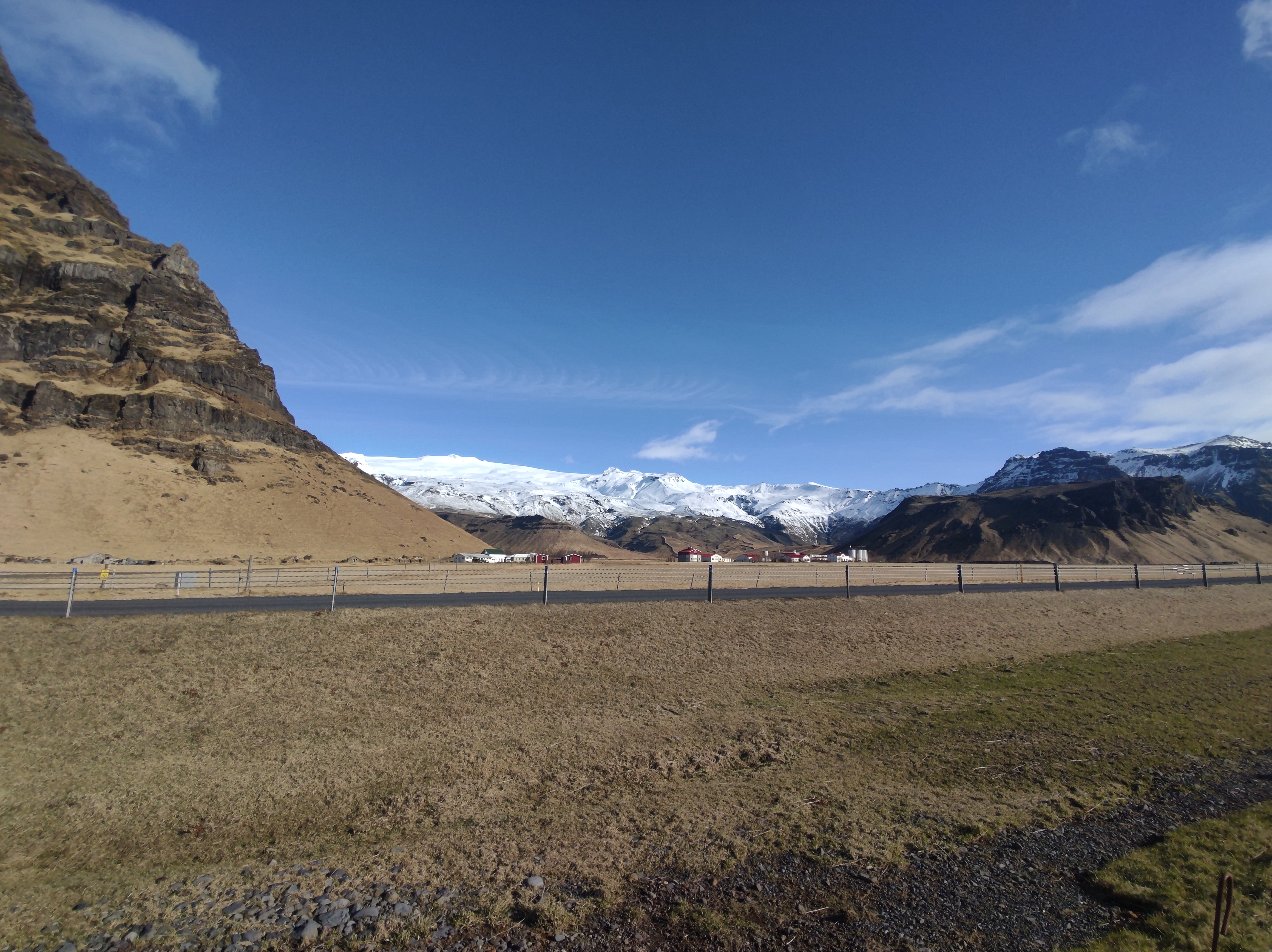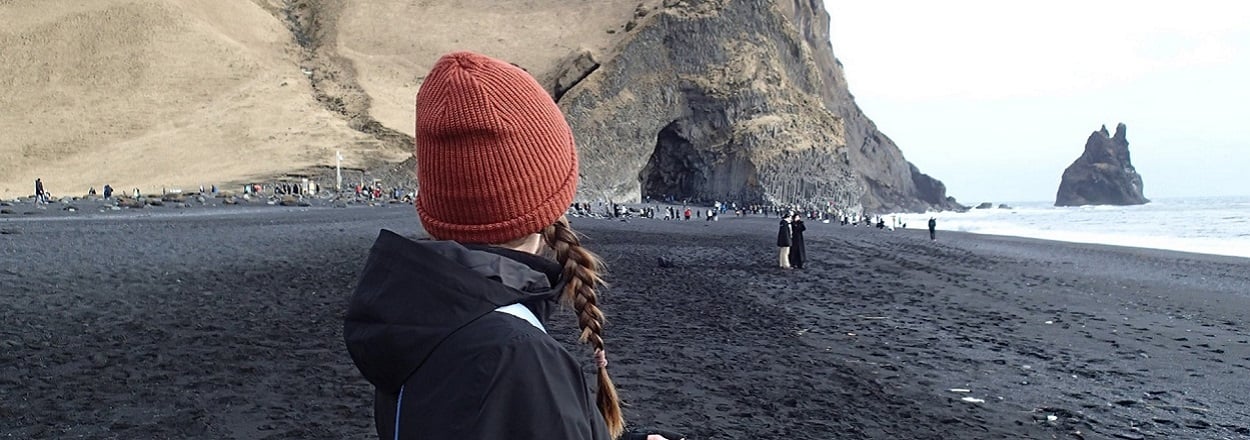In the spring of 2024, my husband Jake and I went to Iceland. The Land of Fire and Ice, baby. Volcanoes, glaciers, geysers and more, we were ready to conquer every type of terrain and eager to feast our eyes on so many of the island’s natural wonders. But, among all the incredible things this bucket list destination had to offer, only one was the apple of my eye: the basalt columns of Reynisfjara Black Sand Beach. The result of volcanic activity thousands of years ago, these towering hexagonal formations had me, an avid fan of geologic time, in a chokehold, and I was determined to see them for myself.
Luckily, I’m not the only one who feels this way. In fact, Iceland’s South Coast, the place where Reynisfjara Black Sand Beach and so many other Icelandic hot spots reside, is one of the country’s most sought-after tourist destinations with thousands of visitors enthusiastically boarding vans and busses each year to be whisked away to this magical place — if only for a day. Jake and I joined these ranks and made my rock-loving dreams come true in the process when we booked the “South Coast Adventure Tour” through local tour operator Wake Up Reykjavik.
Thinking of embarking on a similar adventure? Here’s everything you need to know.
The Logistics
Before we get into the good stuff, let’s take a moment to talk logistics. Upon booking our tour online, we were asked to select a pickup location from a long list of places in Reykjavik. From bus stops to hotels, the list was expansive, and we were able to choose a spot just around the corner from our Airbnb. The next morning, we arrived at the bus stop several minutes before departure, as requested in the instructions, and were swiftly picked up by our kind and knowledgeable tour guide. We made a few more stops around the city to gather our fellow tour-goers before beginning our adventure, which, btw, was scheduled to last nine to 10 hours.
10 hours is a long time, but don’t worry, I have some quick advice for making it through the day. First things first, having a solid snack stash is imperative. While our van stopped at a gas station early on, we were happy to have our trusted water bottles, granola bars and sandwiches on deck when hunger began to strike. Another thing worth noting that most people considering a trip to Iceland probably know by now is the weather can change on a dime. While we had an uncommonly nice day with clear skies and sunshine, depending on the time of year, nasty conditions like wind, rain and sleet are the norm. Be sure to bring layers, and remember the old saying, “There’s no such thing as bad weather, only bad clothing."

The Stops
Eyjafjallajökull
Thanks to exceptionally nice weather, our South Coast tour kicked off with a bonus stop at Eyjafjallajökull, an ice cap that sits atop the caldera of an active volcano. If the name sounds familiar, it’s probably because this region made headlines in 2010 when the volcano erupted and caused major disruptions to air travel for nearly a week. Our visit here was short and sweet at just 10 minutes long, allowing us enough time to read some signage and snap photos of the ice cap from across the street. Upon returning to the van, our guide taught us how to pronounce Eyjafjallajökull’s challenging name — “ay-uh-fyaat-laa-yow-kl” — and shared his challenges learning the Icelandic language as a foreigner. Interestingly, he said Icelandic is a dying language and it’s incredibly difficult to find resources, whether that be native teachers or apps, to learn it.


Skógafoss
At 80 feet wide and 200 feet tall, the next stop was breathtaking Skógafoss, a powerful waterfall that doubles as one of Iceland’s most iconic sights. As we made our approach, I was taken by Skógafoss’ beauty, which, was essentially a scene straight out of a fairy tale with rolling hills, jagged cliffsides and even a double rainbow for good measure. After vetoing a challenging hike up the waterfall’s side, we approached the natural wonder from its base, getting so close we could feel the spray. From here, we did our touristy duty and snapped a few photos before taking an opportunity to relish the moment. I particularly loved watching the seabirds swoop and sing which earned me an unwelcome souvenir as one of them pooped on my jacket. While we didn’t take advantage of the amenities at Skógafoss, this stop offered a bathroom break and small snacks for those interested.

Sólheimajökull
15 minutes west of Skógafoss was stop number three: Sólheimajökull, the fourth-largest glacier in Iceland. Upon rolling into the parking lot, our guide shared it takes about 15 minutes to reach the glacier via a short hiking trail. Sadly, he revealed, this hike is evidence of the rapid rate Sólheimajökull is melting as the massive chunk of ice used to extend to the lot’s edge. If it continues to melt at its current pace, scientists predict Sólheimajökull will be gone in less than 200 years. As we began our trek, we were met by a cool breeze, which, we decided, made sense as we were essentially walking into nature’s freezer. After several minutes of hiking in our many layers, we finally reached the viewpoint and were impressed as we took in the sheer size of the mile-wide glacier that stood before us. Feeling small amidst this wild, wild landscape, I marveled at Sólheimajökull’s textured crevasses and colorful stripes, evidence of volcanic eruptions many years ago. On our return, we took time to admire the glacial lake to our right, which our guide warned is 229 feet at its deepest — that’s taller than Reykjavik’s Hallgrímskirkja —, something he didn’t want us to learn the hard way by falling in.


Reynisfjara Black Sand Beach
If you haven’t gathered by now, Iceland is a beautiful, but dangerous place, and Reynisfjara Black Sand Beach is one of its most deadly. Situated alongside the North Atlantic Ocean, here, mighty waves travel thousands of miles before violently crashing into the shore, drenching anyone who gets in their way in the process. Dubbed “sneaker waves,” in the most tragic scenarios, the unrelenting surf seemingly manifests out of nowhere, knocking over, and dragging in, unsuspecting bystanders. The dangers of Reynisfjara are to be taken seriously, and, short of shutting it down, Iceland has taken measures to warn tourists of its potential risks. Upon entering the beach, we observed a large sign with a color-coded system and learned conditions were “yellow,” or at a medium hazard for the day. Next, we peeked at a sign that outlined which parts of the beach were deemed “safe” and were warned never to turn our backs to the sea. How’s that for ominous?
Cautiously, we took our first steps onto the black sand, and good news, readers, my basalt columns were still on the agenda. Feeling a bit paranoid about the precariousness of the place, I was happy to find the beach’s main attractions, the basalt columns and a massive basalt sea cave called Hálsanefshellir, weren’t far from the parking lot. As we approached the incredible formations, I was filled with glee, marveling at the rocks’ jagged edges and bizarre growth patterns. It was truly something to be seen. Due to its striking appearance, Reynisfjara is a popular photo spot, and Jake and I were no exception, thoroughly documenting our experience at the top of the world.

Vík í Mýrdal
After we all returned safely (and dry) from Reynisfjara, we headed around the bend to Vík í Mýrdal, a tiny fishing village on the coast more commonly referred to as “Vík.” The definition of picture-perfect, the town is home to just 318 people. Despite its fun-sized population, our tour guide said Vík is growing in popularity among visitors, and many of the people who live there are foreigners forging new lives in Iceland. Upon stopping in a church parking lot at the top of a hill, our guide shared he took his wife to the very same spot when they first moved to Iceland; he wanted to move there; spoiler alert, she said “no.” Apparently some towns are just too small, even by Icelandic standards. However, from the top of the hill, it was easy to see how some people found comfort in the town’s serenity with little more than coastline and rugged scenery stretching as far as the eye can see.

Seljalandsfoss
By our final stop, we were starting to lose steam — so much adventure in one day will do that to you —, but there was one more legendary South Coast sight to see: Seljalandsfoss. Part of the Seljalands River originating from Eyjafjallajökull, Seljalandsfoss is a majestic, 197-foot waterfall. And, aside from being generally glorious, — it’s an awesome waterfall in the middle of Iceland, what more could one want? — Seljalandsfoss is most famous for being “the waterfall you can walk behind,” and when conditions allow, visitors can do just that. While we were intrigued with the idea of going behind the falls, upon seeing people leave the other side completely drenched, we decided against it. Whether you take the risk or not, getting soaking wet in the middle of March is not my idea of fun, a stop at Seljalandsfoss is worth it for the scenery alone. And, while we didn’t have the energy, visitors could easily make the trek to neighboring Gljúfrabúi, a secret waterfall hidden within a rocky outcropping.






Paula F | 05/02/24 - 07:34 AM
I have a couple who wants to go to iceland,not sure of where or what part of Iceland. this will be their first time. What do you recommend?
| reply